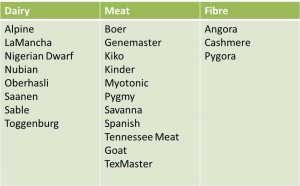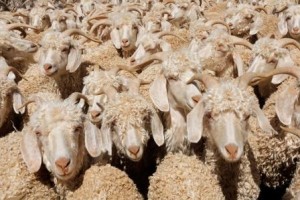Choosing the right breed
Selecting the right goat breed for the environment is a key element in achieving sustainable production. This relates not only to the genetic ability to produce food of the desired type, quality and quantity (milk, meat, hair) under the prevailing conditions, but most importantly as to whether or not the animal can flourish within the natural environment without undue reliance on excessive inputs or intrusive management. This includes the ability of a particular breed to survive the climatic conditions within which it is farmed, as well as the potential environmental stresses associated with the local terrain, seasonal fluctuations in feed supply and water, the inherent disease risk factors and the predators which may share its environment.
 Studies have shown that there is a lack of genetic structure among goat breeds when compared with other domestic farmed species. This may mean that many of the breeds used are sufficiently flexible to be productive across a range of environments (Carvalho et al., 2015).
Studies have shown that there is a lack of genetic structure among goat breeds when compared with other domestic farmed species. This may mean that many of the breeds used are sufficiently flexible to be productive across a range of environments (Carvalho et al., 2015).
Breed types
Goat breeds can be broadly classified into those that are most suitable for dairy, meat or fiber. A list of some of the more common breeds is shown in the table. More comprehensive lists of goat breeds are provided at a number of websites, including the Oklahoma State University Goat Breeds and the Guide to Goat Farming in India sites.
Breed improvement
Given that goats commonly have multiple births, a relatively short generation interval and good heritability estimates for production and conformation traits, there are good opportunities for genetic improvements.
There are some breeding programs that have been developed for goats, and these focus on production traits with some consideration of adaptation to the local environmental conditions and the availability of feed resources. In France, the ICC (Index Combine Caprine) estimates breeding values for milk, protein and fat content, mainly for the French Alpine and the Saanen breeds.

There are a number of national breed selection programmes that focus on milk yield that also consider health, nutrition and environment but few that incorporate indigenous breeds.
Scores for the shape and attachment of the udder and the placement of teats has also been developed and consideration is increasingly given to functional traits that influence health and welfare, such as somatic cell counts (see goat mastitis)(Leboeuf et al., 2008). In Spain, selection programs have been developed for improving milk production of local breeds such as Murcrana Granadina, Malagueňa and Majorera (Analla et al., 1995) and more recently on breeding for intensification, with some consideration of achieving sustainability through more efficient use of natural resources, particularly agro-silvo-pasturing (browsing and grazing) and agro-ecological approaches (Nahed et al., 2006).
Genetic evaluations of US dairy goats from records available through Dairy Herd Improvement programs and the American Dairy Goat Association also focus primarily on production as well as physical characteristics associated with breed type, such as stature, rump angle, teat and udder position and attachment (Wiggans and Hubbard, 2001). The prospects of considering life-time performance and longevity of dairy goats in the US are considered by Castañeda-Bustos et al (2014). There are also national goat breeding programs in a number of other countries, including Brazil (Braga Lôbo et al., 2010) and Mexico (Montaldo et al., 2010). There are only limited examples of successful sustainable breeding programs in the tropics that utilize indigenous breeds (Kosgey et al., 2006).
Resistance to parasites
There is some evidence to show that some breeds are more resistant or resilient to gastro-intestinal parasites than others (e.g. Chauhan et al., 2003; Baker et al., 1998; Chiejina and Behnke, 2011) and the impact of parasite burden on milk production is greater amongst those breeds that have been selected for yield as compared with those that are considered rustic or indigenous. However, it is unclear whether tolerance is associated with a genetic resistance or differences in production potential (Alberti et al., 2012) as level of milk production in dairy goats may influence the resistance and/or resilience to parasitism (Chartier and Hoste, 1997). Breed differences in resistance have been shown to be particularly marked over the lactation period.
Breeds and breeding
Whilst there are minor differences between breeds with regard to the length of pregnancy, there are significant differences between temperate and tropical breeds with regard to breeding season. Temperate breeds are seasonal breeders whereas those in the tropics breed all-year-round. This is largely controlled by daylength. There are also breed differences with regard to ovulation rate, which in turn impacts on litter size and behaviour at estrus (Fatet et al., 2011). Visit the Goat Reproduction and the Goat Behavior pages for more information.


 British English
British English


Comments are closed.